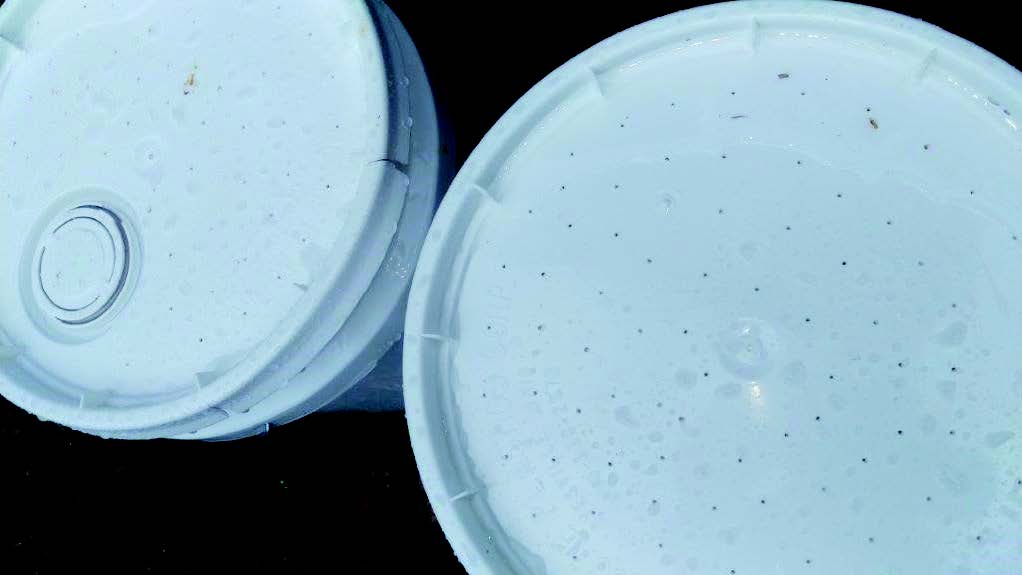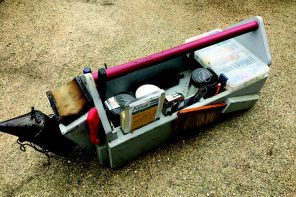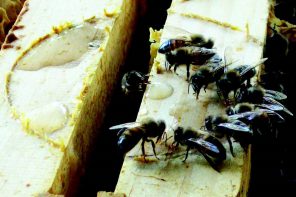Volume, Cost, Small Hive Beetle And Time All Add Up
By: David MacFawn
Feeding your bees for their survival is critical if they are out of food. Sugar syrup feeders and pollen feeders are important for feeding. Each type of feeder has its place. In the southeast the pollen feeder has replaced pollen patties due to Small Hive Beetles (SHB) reproducing in pollen patties.
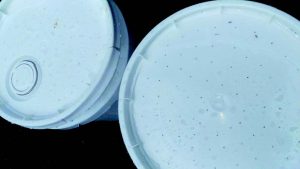
Pail Feeder Lid
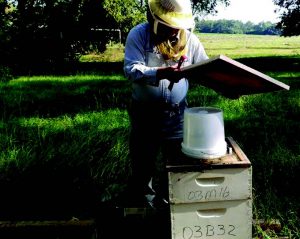
Pail Feeder on inner cover.
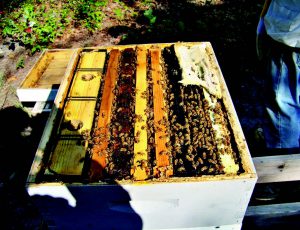
Frame Feeder
Sugar Syrup Feeders
Pail feeders are inexpensive (about $8 for a two gallon). However, they do require an inner cover. The pail feeder is inverted and the pail sides squeezed and released to create a vacuum so the feeder will not leak. Then the feeder is placed over the inner cover hole on the inner cover. Pail feeders are easy to fill, transport, and clean. Most beekeepers place a deep super around the pail feeder to prevent hive issues with weather, animals and robbing. Tiny holes punched in the lid or a screen allow the bees access to the syrup. If you punch, use a small hive nail. If you use a migratory cover without an inner cover as your standard configuration, you will need to use an additional inner cover to place the pail feeder on.
Frame feeders, also known as Division Board feeders, work well in warm weather. However, in cold weather the bees may not be able to access the sugar syrup. Frame feeders are easy to fill when the feeder is placed on the side of the brood chamber or super. The super above is merely slid over, the frame feeder filled, then the super slid back into place. A float, such as a twig or popsicle stick, or other material needs to be placed in the frame feeder to keep bees from drowning. Cleaning the frame feeder may be tricky since it needs to be removed from the hive.
Jar feeders work well in warm weather or cool weather in the southeast. In much of the southeast it rarely gets below about 25°F. Sugar syrup will typically not freeze in much of the southeast. Bees can access the syrup in warm or cool weather. When the bees move upward through the equipment stack in the Winter, and they exhaust their honey stores and reach the feeder, the bees can huddle under the feeder and access the sugar syrup. Jar feeders are inexpensive, the jars can be transported easily, and cleaned easily. It should be noted glass jars may break in the beeyard causing an issue. Thick plastic jars are recommended; thin plastic jars will collapse.
A 10-frame hive top feeder (also called Miller Feeders) with floats costs around $27. A two gallon pail feeder costs around $9, plus an inner cover which cost around $11 means the beekeeper has about $20 initial invested. Therefore, a hive top feeder configuration is about $7 more expensive than a two-gallon pail feed configuration. If you only have a few hives it may not matter. A hive top feeder is easier to refill than a pail feeder which results in less management time. With hive top feeders, the bees access the syrup via the opening between the reservoirs.
Mold in both will need periodic cleaning. Use of Honey Bee Healthy has been proven to reduce mold in all types of feeders. Hive top feeders will hold greater than two gallons, and a pail can hold about two gallons. The feeder size is important if the beekeeper has outyards. Larger feeders are preferred for outyards so you do not have to make as many trips.
Yard, or open, feeders should be at least approximately 200 feet away from the apiary to prevent robbing. A yard feeder may be as simple as a bucket with straw so the bees do not drown in the sugar syrup. However, the issues with yard feeders are:
Weak colonies may not get their fair share of the sugar syrup
They may spread diseases
The bees cannot access the sugar syrup in cold weather when the bees do not fly (typically less than 48 to 50°F)
However, yard feeders have their place for time efficiency and reduced labor.
Boardman entrance feeders should only be used to dispense water. Period!! Feeding sugar syrup via a Boardman can allow robbing. Also, feeding sugar syrup via a Boardman in the Winter results in the bees not being able to access the syrup if the bees are clustered. Visible clustering occurs at 57°F. Boardman feeders are inexpensive, only around $5 plus the jar cost.
If you are a Top Bar Hive user, I refer you to Dr. Wyatt Mangum’s Top-Bar Hive Book for feeding discussions.1
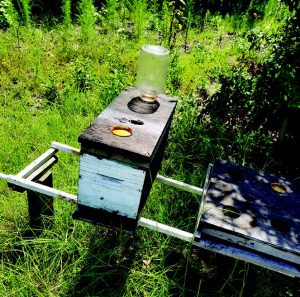
Jar Feeder
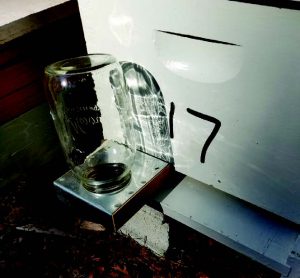
Boardman Feeder
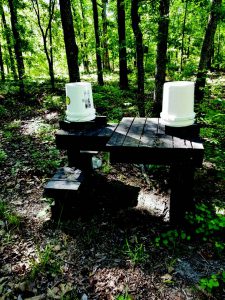
Pollen Feeders
Pollen Feeders
In some locations there may be seasonal pollen dearth’s. Pollen dearth’s are especially critical in autumn when the winter bees are developing. Lack of pollen will reduce brood production even if you have plenty of nectar/honey. It takes pollen and honey to produce young bees. Hence, it may be viable and important to feed pollen substitute to stimulate brood production.
Several methods are available. The beekeeper can feed pollen patties or dry pollen in feeders. Pollen patties have lost favor in the southeast due to small hive beetles (SHB) reproducing in the pollen patties. Dry pollen in pollen feeders has replaced pollen patties as the method of choice in the southeast. A pollen feeder may be as simple as a pail turned 90 degrees on it’s side and nailed on a tree (Figure 7) or a more elaborate pollen feeder (Figures 8 & 9).
Another way to feed dry pollen substitute is to place a small amount on top of an inner cover. However, you need to watch if the pollen substitute gets wet from the hive moisture and attracts SHB. Putting pollen substitute on top of an inner cover will help colony pollen shortage in cold weather when the bees cannot fly.
Pollen patties used to be placed immediately above the brood nest. A small quantity was used to minimize attracting SHB and an amount that the bees could consume in a couple days. However, each hive had to be opened which required a lot of time.
In Closing
Each type of feeder has its use, benefits, and disadvantages. The pail feeder is the most versatile for warm and cold weather. It is also an inexpensive way to feed syrup. Yard feeders are even less expensive but have some disadvantages. Pollen feeders are also important for continued brood production during pollen dearth’s especially in autumn. Feeding dry pollen substitute in pollen feeders alleviates some of the Small Hive Beetle issue inside the hive.
1Mangum, Wyatt A. Top-Bar Hive Beekeeping: Wisdom & Pleasure Combined, ISBN 978-0-9851284-0-1.
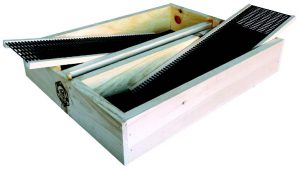
Hive Top Feeder
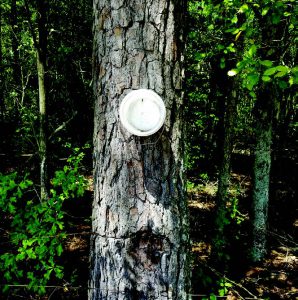
Pollen Feeder






